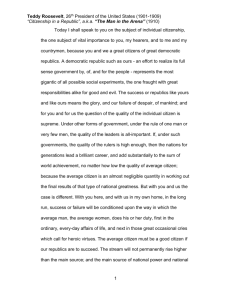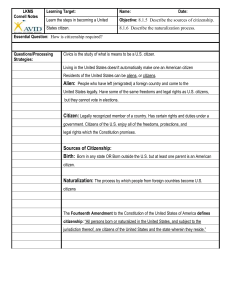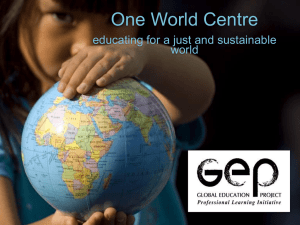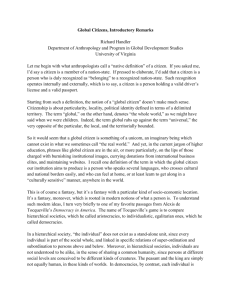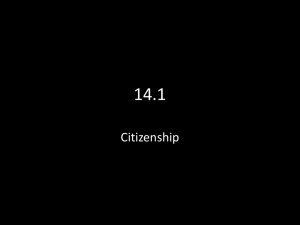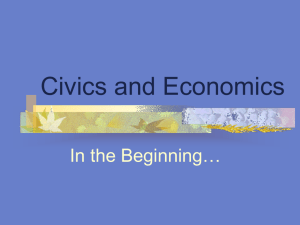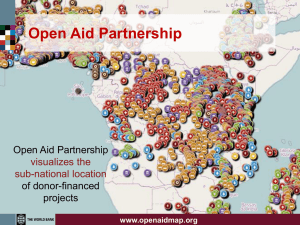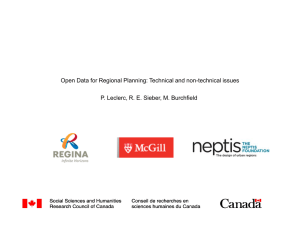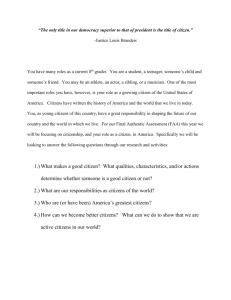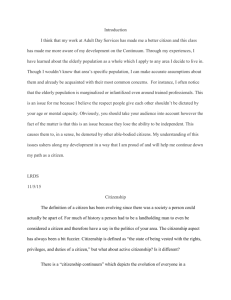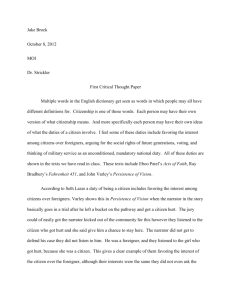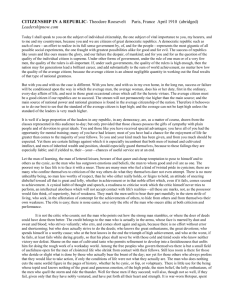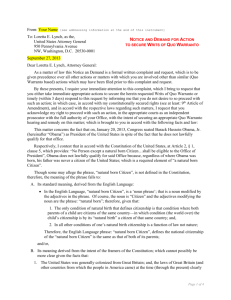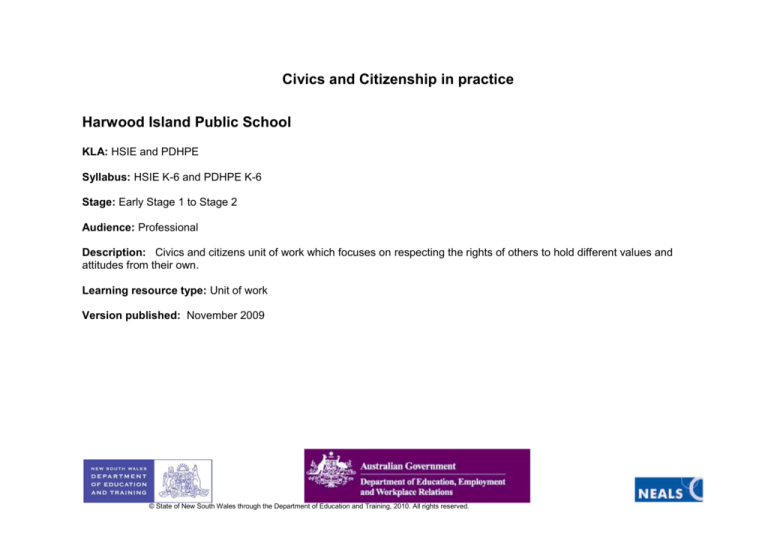
Civics and Citizenship in practice
Harwood Island Public School
KLA: HSIE and PDHPE
Syllabus: HSIE K-6 and PDHPE K-6
Stage: Early Stage 1 to Stage 2
Audience: Professional
Description: Civics and citizens unit of work which focuses on respecting the rights of others to hold different values and
attitudes from their own.
Learning resource type: Unit of work
Version published: November 2009
© State of New South Wales through the Department of Education and Training, 2010. All rights reserved.
2009
YEAR K-2
Civics and Citizenship
HARWOOD ISLAND SCHOOL
(Taught in conjunction with PDH units of work on Values)
OUTCOMES
V2
V3
Respects the rights of others to hold different values and attitudes from their own.
Enjoys a sense of belonging
DMES1.2
DMS1.2
Recalls past experiences in making decisions.
PSS1.5
IRES1.11
Identifies options available when making simple
decisions.
Seeks help as needed when faced with simple
problems.
Identifies how individuals care for each other.
GDES1.9
Identifies how people grow & change.
GDS1.9
Draws on past experiences to solve familiar
problems.
Identifies the ways in which they communicate,
cooperate and care for others.
Describes the characteristics that make them
both similar to others and unique.
PSES1.5
LESSON
1
2
IRS1.11
LEARNING EXPERIENCE
Display pictures of various families doing different activities together.
Discuss what they are doing & if they look happy together.
Encourage students to be positive & non judgemental. Compare the different pictures:
are there any similarities? How are they different or the same as their family?
Use a bubble diagram to record some of the special things the class like to do with their
family. Highlight the similarities.
Recap on previous units of work around the value placed on things that are important to
us. Discuss how each family value different activities eg. visiting the grandparents
weekly, eating dinner together at the table, joining a sporting team etc.
Students make a diorama of a special activity they value doing with their family.
Discuss how families not only have special things they do together, but also have their
own special rules.
List the Family rules we have in common with other class members under the heading
Family Values.
RESOURCES
Shoe boxes
Construction paper
Glue
Masking tape
Paints
List of school rules
3
Discuss what our school values are, and how these determine our rules. What are the
consequences when we break these rules? Do people get hurt or upset?
Explore the idea that the community we live in is like a big family and values many of the
same things, these values are rules we live by called laws. Discuss some of these laws
and what would happen without them.
Act out some scenarios demonstrating school rules or laws and consequences if they
are broken.
Brainstorm “What is a Good Citizen?”. Record all ideas on the white board.
Discuss that a good citizen is: someone who cares for others, their community and the
world around them (include the idea of values and not breaking the rules).
Students work in pairs on computers to make their own class poster stating what they
think is a good citizen and decorate it with pictures, depicting acts of good citizenship.
Students share posters with the class.
Contrast these ideas with “What is a bad citizen?”.
Computers
4
In What Way are you a Good Citizen? (at school)
Give each student a large circle of coloured paper & draw a smiley face on them.
Each student to write (Kindergarten illustrate) around the face, the type of things they do
at school which make them a good citizen.
Display faces on a large sketch of a classroom.
Decide upon some class jobs that could be performed to benefit the class/ school then
nominate people for these positions on a rotational basis eg power police, water police,
lost property person, fish pond monitor etc
Large circles of coloured
paper
Large classroom sketch
Jobs chart
5
Discuss the statement “You’re only children and can’t do much”.
Is this true? What sort of things can you do? (in the community)
Make a class sign stating: Every individual can make a difference!
Students write or draw ways they are a good citizen in their community.
The teachers trace portrait silhouettes of children using an OHP.
Students then paint their silhouette and attach the ways they are good citizens to the
bottom of their silhouettes.
Students can play guessing games ie. whose silhouette?
Large sheet of cardboard
Construction paper
Overhead projector
Black paint
6
Together we can make a difference.
Construction paper
Brainstorm and make a class list on the whiteboard the type of things we are doing and
Pencils
can do to make our school / community a better place to live e.g. planting trees in our
Felt pens
rainforest environment, having our compost and recycling bins, joining in our annual
Glue sticks / stapler
Clean Up Australia Day etc.
Students then cut out tracings of their hands and colour them. Next, attach your hand cut
outs to others nearby and continue until all the hands in the class are joined, forming one
long chain of hands. Recap how, when we work together, we can make a difference.
7
Begin weekly ‘Citizen of the week’. Each Friday students nominate someone who has
been a good school citizen. They may have done acts of kindness to others, good deeds
such as picking up rubbish or helping with special jobs around the school.
Each child is given a cardboard star to decorate. Amongst the decoration they must
include their name and a picture of themself, which they can print off from the school
photo bank on the computers.
Each week the student/s who has been nominated as class citizen of the week, will have
their star posted on the class door for the week and be given a class award.
Cardboard stars
Pencils
Felt pens
Glue
Glitter
Stickers
Computers
8
Play the song to children ‘From Little Things Big Things Grow’.
Discuss the meaning of the title and chorus. Discuss some egs of this, like how the
clean Up Australia Day has grown from the idea of one person.
Brainstorm some ideas on ways the class could show their civic duty, by doing
something for the local community e.g. something as simple as fundraising for a local
cause, or putting on a special morning tea and performance of some dance/singing
items for the elderly in the community etc
CD player
CD ‘From big Things
Little Things Grow’
9&10
Discuss and list on the whiteboard those people in our community who we value. Divide
these into two groups, jobs and volunteers e.g. Nurses, Police / SES, Meals on Wheels.
Explain the difference.
Students work in small groups (Kindergarten with yr 2 children) researching volunteer
groups and putting together a short slide presentation to present to the class.
Computers
11
Students share slide presentation on volunteers with other school members on the IWB.
Perform the civic duty which was agreed upon by the class.
Take photographs and publicise in the school newsletter and local newspaper.
Computers
IWB
School camera
Student Assessment
Observe students’ participation in group tasks and class
activities.
Gather student work samples for assessment folders.
Completion and presentation of dioramas
Student participation in role play activities.
Student presentation of good citizenship poster
Completion
Unit Evaluation
Were there sufficient opportunities for all students to
participate?
Do
students understand what being a good citizen entails?
Was
sufficient time allocated for students to complete
activities?
and presentation of silhouettes and good citizen
outline
Participation in student Star of the week.
Presentation of research work in short slide show format.
Student participation in fundraising activity or special
performance.
Were
there positive changes in student social behaviour?


